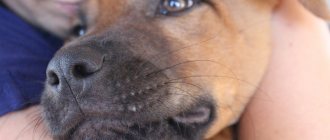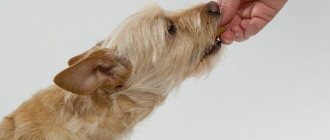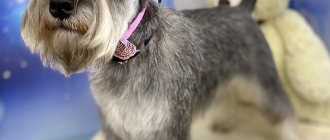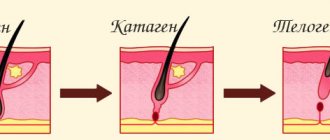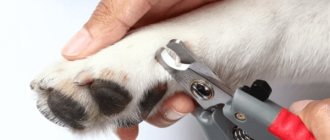If your dog has not been with you since birth, you may not know its exact age. And now her fur, especially around her muzzle, is turning grey. Does graying hair around the face mean a dog is getting old? Or is this a sign that something is wrong with her?
Gray hair on and around a dog's face is a natural occurrence as he ages. Because dogs age faster than people, they also go gray earlier than their beloved owners. And just like people, some dogs go gray much earlier than others.
Do dogs go gray?
Many people think that only people go gray, but dogs are also susceptible to it. When going for a walk with your pet, you probably noticed gray hairs or an entire area on the body of some animals.
Just like people, dogs do not always turn gray with age; quite often it depends on the hereditary predisposition or temperament of the pet itself.
The size of the pet is not associated with the appearance of gray hair, but it has been observed that some breeds begin to gray very early. For example, brown poodles usually turn gray after two years of life.
The health of the dog does not affect the appearance of gray hair. Your dog can be completely healthy, cheerful and cheerful, but at the same time gray-haired. Gray hair can completely cover some areas of the body or be small spots on the face.
Dogs with coarse hair may have gray hair not only in their beard, but also in their mustache. Don't worry, because this is completely normal.
As a rule, females are much more likely to go gray than males.
Why does gray hair appear prematurely?
As you have already seen, premature gray hair in a dog can have different causes.
It is important to know you in order to take appropriate measures in a timely manner. this allows you to reverse this development and avoid problems that could affect the dog's health.
One of the causes of premature gray hair may be an insufficient diet. Sometimes discoloration of a dog's hair is attributed to a lack of nutrients. this can happen, for example, in dogs that do not eat meat.
When your four-legged friend with gray hair also shows symptoms such as laziness, loss of appetite or weight loss, it could be an infection from parasites or even something more serious.
In this case, it is necessary to take him to the veterinarian so that he can be examined and treated accordingly.
In fact, stress is one of the most common causes of gray hair in dogs.
Causes of gray hair in dogs
In 2011, a team of scientists led by Robert Lefkowitz conducted a study on the influence of various factors on the appearance of gray hair in dogs.
Animal owners were given questionnaires in which they asked about their pet’s behavior, age, health, whether it is afraid to make contact, whether it often gets scared, whether it spoils things, whether it loses fur, and many other factors.
Impulsivity of behavior was assessed separately. The questionnaire asked whether the pet jumps on people or shows activity after a walk in order to identify the dog’s anxiety level.
Then they took several photographs of the animals and compared the results of the questionnaire with the photograph and the volume of gray hair on the dogs’ fur. At the same time, light-colored dogs, on which it was difficult to detect gray hair, did not take part in the study.
To ensure that the assessment was not subjective, independent experts were involved who had not seen the dogs before or interacted with them. These people had to rate the dog's behavior from one to three points.
Consequences of whisker trimming in animals
To understand why you shouldn’t resort to trimming your mustache (except for these cases), you should look at the consequences that occur for the animal:
- One or more of the senses disappears. The perception of the world around us completely changes. The pet begins to navigate worse.
- The dog begins to receive significantly less information about the world around him. Because of this, behavior also changes. The pet becomes nervous, irritable and even aggressive.
- Older dogs suffer the most. For older dogs, the sudden loss of whiskers results in a strong blow to the nervous system. This can also affect the physical condition of the pet. Diseases, of course, do not develop, but the dog may refuse food for some time and be lethargic.
How to eliminate the causes
Researchers have identified a relationship between an animal's anxiety and fear and the appearance of gray hair. Most often, pets lose color if they do not calm down for a long time after training, damage household items when left alone, and are afraid of strangers and atmospheric phenomena.
If your dog is afraid of strangers, loud noise, thunder or thunderstorms, new places, then all these factors put your pet into a state of deep stress. Which negatively affects the animal’s quality of life and also contributes to the appearance of early gray hair.
You need to observe the behavior of your pet and identify those factors and phenomena that he is afraid of, try to avoid them, and in case of fear, try to calm the animal with a soft voice and affection.
Why are vibrissae needed?
Why do dogs need whiskers? To answer this question, you need to understand a little about their structure. First of all, vibrissae are very sensitive hairs with a large number of nerve endings. In contact with surrounding objects, the whiskers send a signal to the animal’s brain and provide information that helps to move. In other words, dogs need vibrissae in order to better navigate in space. In addition, the mustache improves tactile perception and helps the dog in finding food or identifying other animals.
It should be understood that there is no need to trim dogs' whiskers, since this leads to a kind of inferiority of the animal. The pet will be less able to navigate the area.
Important! The same applies to cats, but for them the whiskers are an even more important element than for dogs. If cats' whiskers are cut off, they become completely lost in space.
Helps to navigate in space
Gray hair = old age?
Among dogs, there are often individuals with whitish muzzles or sides, but it is impossible to judge with one hundred percent certainty just by these signs that such an animal is necessarily elderly. There is an opinion that gray hair appears in dogs that have reached a certain age, and differences have even been allegedly established depending on the standard size of the breed. Thus, large dogs turn gray at the age of 6, medium dogs at the age of 7, and small dogs at the age of 8. But, in fact, it is not age that affects the appearance of gray hair.
Of course, puppies do not have gray hair, but old animals are not always gray. And vice versa - if you see gray hair on a dog, this does not mean that it has lived a long time. For example, poodles that are brown in color may begin to see the first gray hairs in their coats when they are two years old.
What breeds can have their whiskers trimmed?
For some breeds, it is recommended to trim their mustache. This applies to:
- poodles;
- Pekingese;
- Chinese crested;
- Shar Pei;
- mastiffs;
- cocker spaniels;
- retrievers.
I recommend: Dog muzzle, how to choose
Please note! You cannot remove the mustache completely. You just have to monitor their length and trim them when there is a threat that they will harm your pet.
Poodles and Chinese Cresteds experience no discomfort at all after a haircut. Their whiskers have already degenerated into the skin. Therefore, without them, dogs also navigate well in space and their well-being is not affected.
Hard life - as the main factor in the appearance of gray hair
According to scientists, there can be many reasons for the appearance of gray hair in dogs, so it is almost impossible to determine unambiguously why it appears. But it has been definitely proven that under the influence of frequent stress, a dog’s muzzle begins to become gray. True, in some exceptional cases, gray hair may first begin to appear on the back or sides.
This is how the effects of stress hormones – adrenaline and noradrenaline – manifest themselves. Moreover, being under constant stress can have a negative impact not only on the pigmentation of the coat, but also on the genetics of the pet.
Where do whiskers grow?
Vibrissae in dogs grow exclusively on the animal's face. Vibrissae are the same whiskers, this is just their scientific name. The singular form will be called vibrissa.
Antennae grow on the cheeks, above the eyebrow, on the chin, near the lips. Some are clearly visible, others are too short and are not visible against the background of the general fur.
Their main difference from wool is the denser structure of the hair.
In addition, the color of the whiskers is much darker, so they can be easily distinguished on light fur. However, if the dog's hair is dark and long, the whiskers may not be noticed and can be cut off. Therefore, experts recommend contacting haircutting professionals. Important! In short-haired dogs, such as Chihuahuas, Jack Russells, and pugs, the whiskers are much more visible. While it is almost impossible to find them in Spitz, York, and Maltese dogs.
Gray hair in dogs
Did you think that large dogs turn gray from 6 years old, medium ones from 7, and small ones from 7-8, when dogs enter old age? You are wrong, a pet can turn gray at an earlier age. Part of this depends on genetic predisposition, such as when the dog's mother and father or grandparents turned gray (if this can be determined). For example, it has been observed that poodles with brown hair are gray already at 2 years of age.
Early gray hair has nothing to do with a dog’s health. A dog can be young, healthy and vigorous, but gray-haired. Similarly, early gray hair occurs in people. Your pet may turn completely gray early, or gray hair may cover its back or appear on its face.
In wire-haired dogs, gray hair may appear in both the beard and mustache. Don't worry, your pet is healthy.
There are various hypotheses about why dogs turn gray:
- Melanocytes are produced in smaller numbers and their function is inhibited;
- Hydrogen peroxide does not break down as quickly as before. Less peroxide is produced in the hair follicles;
- Air layers appear between the keratin fibrils. When light hits the hair, it is refracted and the hair appears gray.
You will be surprised, but if your pet is often worried and worried, no matter for what reason, he may begin to turn gray early. Most dogs' faces begin to turn grey.
Main functions
The main point of why dogs need mustaches was discussed in the previous paragraph. However, vibrissae also perform other functions. In particular these are:
- Helps in identifying odors. The structure of these hairs allows the animal to detect odors at a great distance. Therefore, you can often see your pet standing with its muzzle raised and moving its nose.
- Object location recognition. Helps you better navigate in space, including in the dark. This skill is especially useful for hunting dogs.
- Estimation of wind strength and direction.
Street temptations and dangers
In long-haired breeds, the hair on the face can be seriously damaged during a walk. To avoid this, you need to collect the “antennae” and “beard” in bunches using elastic bands. This way, the hair will not become disheveled, and spikelets and burrs from the grass thickets will not get into it. Such a seemingly harmless habit as sniffing different places while walking also poses a great danger to the fur. Due to constant contact with the ground, the hair of the mustache and beard are wiped off, especially if the surface is asphalt.
All the most interesting things on the Internet!
Why does a dog need a mustache?
The dog's name is Rex ©
Information about this magazine
- Placement price 100 tokens
- Social capital107
- In friends
- Duration 24 hours
- Minimum bet 100 tokens
- Rules
- View all Promo offers
- 32 comments
- —
- Leave a comment
The first link in Google:
results
Researchers have found that females tend to have higher graying rates than males. Additionally, dogs that are afraid of loud noises, unfamiliar animals, and people tend to have a lot of gray hair.
“Hello, I’m an Instagramholic”: Anfisa Chekhova on how she became Instagram addicted
You can make convenient flower stands from inexpensive photo frames: an easy way
The subject of appeals to the prosecutor's office are violations of rights by employers
It was also found that graying had nothing to do with the size of the dog, whether it was neutered or whether it had any health problems.
“I was a little skeptical about this hypothesis,” said study co-author Thomas Smith, a college professor at Northern Illinois University. “But when we analyzed the data, the results were actually striking.”
Other studies have shown that stress can also change coat color.
What breeds can have their whiskers trimmed?
Most breeds are strictly prohibited from removing their whiskers. This can lead to changes in the nervous system, which is clearly not beneficial. However, some domestic breeds tolerate this procedure well:
Note! Every mammal needs sense organs. You cannot cut or pluck them without special reasons. This will only bring harm.
